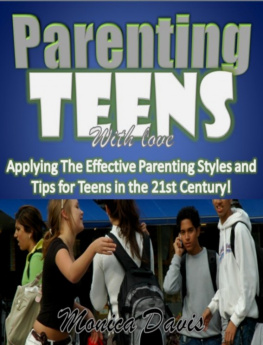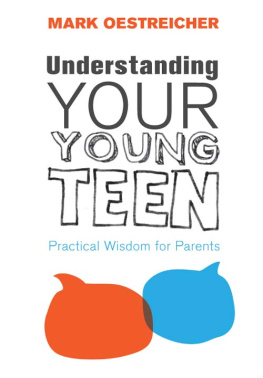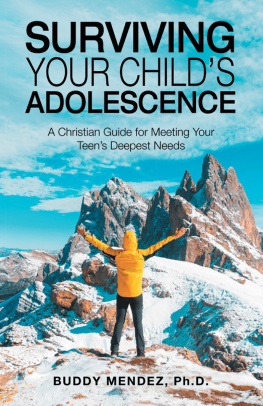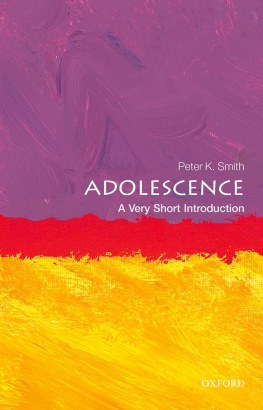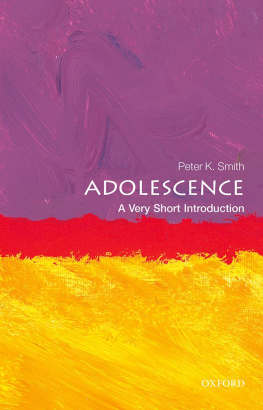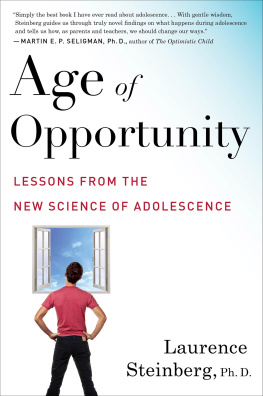Praise for
You and Your Adolescent
Virtually an owners manual for the parents of teenagers... Will help parents understand their adolescents and themselves. I recommend it very highly.
Lawrence Kutner, Ph.D., former Parent & Child
columnist, The New York Times
A calm, measured book filled with thoughtful advice on everything from pimples to pornography, allowances to alcohol... valuable reading.
John Cotter, The Washington Post
Wide-ranging, well documented... This books counsel is well worth considering, and its encouraging attitude is like a breath of fresh air.
Booklist
An important and well-organized manual filled with solid advice for the parents of adolescents... Throughout, the authors offer advice on how to communicate about issues from clothing to college applications, work and birth control. Significantly, the authors communicate the encouraging sense that they genuinely like adolescents.
Publishers Weekly
A comprehensive guide to parenting children who are between the ages of 10 and 20... Practical information and suggestions... Resources are plentifuleverything from rsum guidelines to a drug usage chat to the lowdown on acne and sexually transmitted diseases. An extremely readable text makes the contents readily accessible to teens. Recommended.
Library Journal

ALSO BY LAURENCE STEINBERG
Adolescence
Beyond the Classroom:
Why School Reform Has Failed and What Parents Need to Do (with B. Bradford Brown and Sanford M. Dornbusch)
Crossing Paths:
How Your Childs Adolescence Triggers Your Own Crisis (with Wendy Steinberg)
Rethinking Juvenile Justice (with Elizabeth S. Scott)
The 10 Basic Principles of Good Parenting
When Teenagers Work:
The Psychological and Social Costs of Adolescent Employment (with Ellen Greenberger)

| Simon & Schuster
1230 Avenue of the Americas
New York, NY 10020
www.SimonandSchuster.com |
Copyright 1990, 1997 by Laurence Steinberg and Ann Levine
Copyright 2011 by Laurence Steinberg, Ph.D.
All rights reserved, including the right to reproduce this book or portions thereof in any form whatsoever. For information address Simon & Schuster Subsidiary Rights Department, 1230 Avenue of the Americas, New York, NY 10020.
First Simon & Schuster trade paperback edition January 2011
SIMON & SCHUSTER and colophon are registered trademarks of Simon & Schuster, Inc.
For information about special discounts for bulk purchases, please contact Simon & Schuster Special Sales at 1-866-506-1949 or business@simonandschuster.com.
The Simon & Schuster Speakers Bureau can bring authors to your live event. For more information or to book an event contact the Simon & Schuster Speakers Bureau at 1-866-248-3049 or visit our website at www.simonspeakers.com.
Designed by Ruth Lee-Mui
Manufactured in the United States of America
10 9 8 7 6 5 4 3 2 1
Library of Congress Cataloging-in-Publication Data
Steinberg, Laurence D.
You and your adolescent: the essential guide for ages 1025 / Laurence Steinberg.1st Simon & Schuster trade pbk. ed.
p. cm.
Rev. ed. of: You and your adolescent: a parents guide for ages 10 to 20 / Laurence Steinberg and Ann Levine. 1997.
Includes bibliographical references and index.
1. Parent and teenagerUnited States. 2. TeenagersUnited States. I. Title.
HQ799.15.S74 2011
649'.125dc22
2010033202
ISBN: 978-1-4391-6603-1
ISBN: 978-1-4391-6975-9 (ebook)
To my parents,
Mollie and Irwin Steinberg
The Basics
Chapter 1
Good News About Adolescence
Relax! The horror stories you have heard about adolescence are false.
Adolescence has long been a synonym for trouble in our society. Everyone knows that the road from childhood to adulthood is stormy. Extreme moodiness in adolescence is normal. Rebellion is an inevitable and necessary part of growing up. If your teenager doesnt get involved in drugs, crime, and risky sex, consider yourself lucky.
The idea that adolescence equals trouble has been part of our folklore, handed down from generation to generation, and accepted by psychologists, educators, and parents alike. Psychologists attempted to explain the storm and stress of adolescence through theory. Sociologists concentrated on delinquents, dropouts, drug users, and other problem teenagers. Few questioned the conventional wisdomuntil scientists began to study adolescence systematically, in the late 1970s. Over the past 30 years, a new wave of research has swept through the field. Psychologists began to study adolescents themselveshow they think, what they think about, how they feel about their lives, why they behave as they do, and how they respond to different types of parents. They looked not only at troubled young people, but also at ordinary, everyday kids. As a result of this research, many common assumptions about adolescence have been exposed as myths.
. Psychological problems, problem behavior, and family conflict are no more common in adolescence than at any other stage of the life cycle. To be sure, some adolescents are troubled and some get into trouble. But the great majority (almost nine out of ten) do not. The problems we have come to see as a normal part of adolescent developmentdrugs, delinquency, irresponsible sex, opposition to any and all authorityare not normal at all. They are both preventable and treatable.
Good kids dont suddenly go bad in adolescence.
The evils of peer pressure have been overrated. To be sure, adolescent are concerned about what their friends think; they do want to fit in; and they are susceptible to peer pressure. But peer pressure is not a monolithic force that presses all adolescents into the same mold. Adolescents are as varied as adults are. In some adolescent crowds, earning academic honors is the in thing; in others, its dressing to the nines or excelling in sports. In some, its doing drugs. Peer pressure can be a force for good or evil, positive or negative attitudes toward family and school, depending on the source. Which crowd a teenager associates with is not random. Adolescents generally choose friends whose values, attitudes, tastes, and families are similar to their own. In short, good kids rarely go bad because of their friends.
The decline of the family has also been overstated. In todays world, the story goes, parents have little or no control over their teenagers. The decline of neighborhoods, high divorce rates, women working, the youth culture, the media, and now the Internet all combine to undermine parental authority. This is nonsense. on their childs attitudes and behavior through adolescence and into young adulthood. Adolescents care what you think and listen to what you say, even if they dont always admit it or agree with every point. The majority of teenagers like their parents, respect them, agree with them on the big issues (though they might disagree over matters of taste and style), and want to please them. Good parent-child relationships do not deteriorate because of adolescence. (And this is true whether parents are married, single, divorced, or remarried: Good parent-adolescent relationships do not depend on household arrangements.)
Next page

